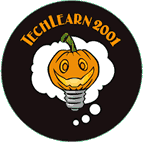Parts of the System
This section of the tutorial examines the Shareable Content Object
Reference Model (SCORM), a specification for standadizing the reusability
and interoperability of learning content. SCORM has been developed
by the Advanced Distributed Learning initiative (ADL).
SCORM focuses on two critical pieces of learning content interoperability:
- It defines an aggregation model for packaging learning content
- It defines an API for enabling communications between learning
content and the system that launches it
These are discussed below.
SCORM also divides the world of learning technology into functional
components. The key components are
- Learning Management Systems (LMS)
- Shareable Content Objects (SCOs)
SCOs are a standardized form of reusable learning object. An LMS
is (for the purposes of SCORM) any system that keeps learner information,
can launch and communicate with SCOs, and can interpret instructions
that tell it which SCO comes next. Additional components in the
SCORM model are tools that create SCOs and assemble them into larger
units of learning.
.

*SCORM stands for Shareable Content Object
Reference Model. SCORM is the brainchild of the Advanced Distributed
Learning initiative (ADL).
Content Aggregation
SCOs are self-contained units of learning. They can be used as
building blocks (or legos) to create packages of SCOs, but they
cannot be broken down into smaller units.. Three things must be
done to create a larger unit of learning from SCOs.
- 1. The SCOs must be found and organized into a structure.
- Instructions must be written that tell an LMS which SCO comes
after which.
- The SCOs and instructions must be bundled into a portable package.
This process is called content aggregation. Note that content aggregation
includes instructions for moving between SCOs but not for movement
within individual SCOs. SCORM has adopted a content packaging format
from the IMS Global Learning Consortium. A SCORM package contains
a manifest file that declares the contents of the package and is
set upt ot describe the order in which the SCOs are to be delivered.
It also tells the LMS where to find the SCOs themselves. The physical
resources represented by the SCO can be physically included in the
package, or they can be referenced externally by the package.
Communicating with Content
The magic of SCORM is that SCORM content can communicate learner
information with any LMS using a standardized method based
on Javascript. The SCORM specification (which derives from work
done by the Aviation Industry CBT Committee) lays out exactly what
pieces of learner information can be retrieved and updated. This
information includes the learner's name, the learner's ID, scores
on quizzes, time spent in a SCO, and the learner's physical device
preferences. It isn't fancy, but covers the basics.
In the SCORM model, content initiates all communication. When it
is launched, it tells the LMS it has started. When it wants something
from the LMS, it asks for it. When it wants to update learner information,
it tells the LMS. And when it is finished, it tells the LMS it is
finished. This passes control back to the LMS, and the LMS decides
which SCO will be delivered next. The delivery order of SCOs is
not yet based on learner information but will be in the future.
Metadata
For learning objects to be used they must be found. It is not easy
to find anything in a large distributed online environment
like the World Wide Web or a large intranet. The solution is to
store not only learning objects but also descriptions of the
learning objects. Thinking of the learning objects as data,
the descriptions are data about the data, or metadata.
Learning object metadata potentially includes information about
the title, author, version number, creation date, technical requirements
and educational context and intent. Learning Object Metadata is
compatible with the metadata used by the digital and online library
community.
SCORM has a place for metadata in every SCO and in every content
package.
|
